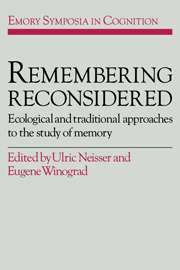Book contents
- Frontmatter
- Contents
- Preface
- List of contributors
- 1 New vistas in the study of memory
- 2 Continuities between ecological and laboratory approaches to memory
- 3 Memory for randomly sampled autobiographical events
- 4 Ordinary everyday memories: Some of the things of which selves are made
- 5 Walking in our own footsteps: Autobiographical memory and reconstruction
- 6 Memory observed and memory unobserved
- 7 The maintenance of marginal knowledge
- 8 The content and organization of autobiographical memories
- 9 The ontogeny of memory for real events
- 10 The functions of event memory: Some comments on Nelson and Barsalou
- 11 “The Wreck of the Old 97”: A real event remembered in song
- 12 Passive remembering
- 13 Remembering without experiencing: Memory for reported events
- 14 What is ordinary memory the memory of?
- 15 Go for the skill
- Name index
- Subject index
5 - Walking in our own footsteps: Autobiographical memory and reconstruction
Published online by Cambridge University Press: 25 March 2010
- Frontmatter
- Contents
- Preface
- List of contributors
- 1 New vistas in the study of memory
- 2 Continuities between ecological and laboratory approaches to memory
- 3 Memory for randomly sampled autobiographical events
- 4 Ordinary everyday memories: Some of the things of which selves are made
- 5 Walking in our own footsteps: Autobiographical memory and reconstruction
- 6 Memory observed and memory unobserved
- 7 The maintenance of marginal knowledge
- 8 The content and organization of autobiographical memories
- 9 The ontogeny of memory for real events
- 10 The functions of event memory: Some comments on Nelson and Barsalou
- 11 “The Wreck of the Old 97”: A real event remembered in song
- 12 Passive remembering
- 13 Remembering without experiencing: Memory for reported events
- 14 What is ordinary memory the memory of?
- 15 Go for the skill
- Name index
- Subject index
Summary
One of the fundamental issues guiding work on autobiographical memory in recent years concerns the role of higher-order cognitive structures in these recollections. Presumably, the influence of such structures is a matter of degree, depending on such variables as the delay between the remembered event and the memory, the cues available at the time of recollection, and the character of the materials remembered. Boldly or timidly advanced, views that attribute a role to such structures require that at least some features of some autobiographical memories involve not the retrieval of mental copies of the original experiences but rather reconstructions based largely on our general knowledge of related everyday affairs. The teeth in this reconstructionist position show when its partisans employ it to explain even those memories that seem to subjects as if they did involve nothing more than the direct retrieval of mental copies.
Until quite recently, Craig Barclay and William Brewer both have defended relatively strong versions of the reconstructionist view of autobiographical memory. Now, apparently, only Barclay does. Both Brewer's chapter and Barclay and DeCooke's chapter respond to challenges to the sort of schema-based approach to mnemonic reconstruction that they have championed in the past. Barclay and DeCooke aim to improve on the previous research in order to offer additional evidence in support of this position. Brewer, by contrast, continues a recent trend toward a more moderate-sounding position (Brewer, 1986).
- Type
- Chapter
- Information
- Remembering ReconsideredEcological and Traditional Approaches to the Study of Memory, pp. 126 - 144Publisher: Cambridge University PressPrint publication year: 1988
- 6
- Cited by



